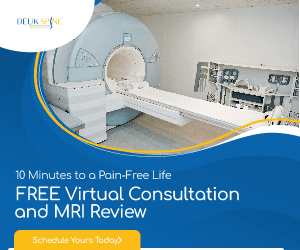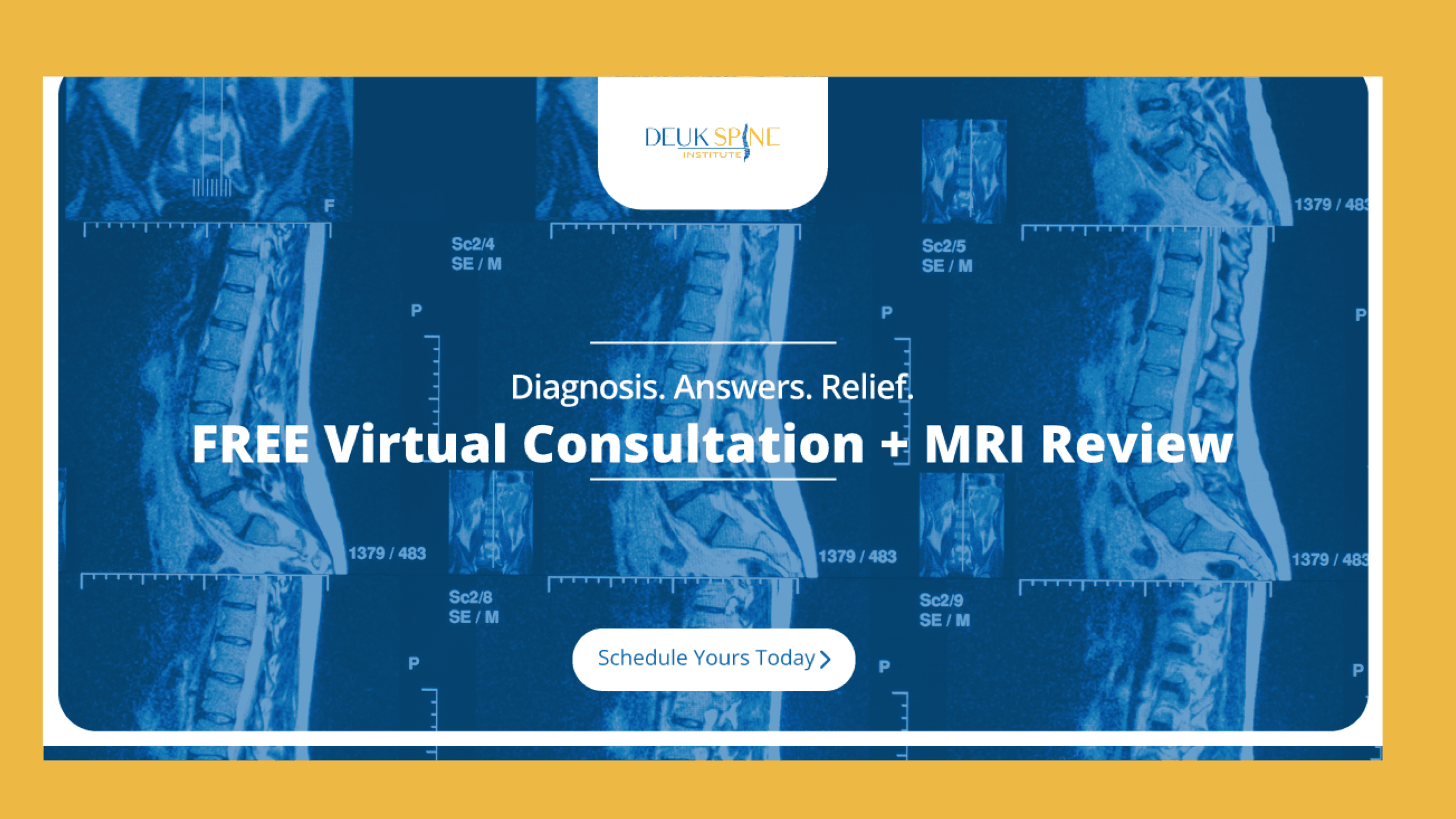Minimally Invasive Spine Care that Gets You Back to Life Faster
by Dr. Deukmedjian
What is a Foraminotomy?

A foraminotomy is a surgical procedure designed to relieve pressure on spinal nerves that have become compressed as they exit the spinal column through the openings called intervertebral foramina. When these pathways narrow—due to disc degeneration, bone spurs, thickened ligaments, or herniated discs—inflammation and nerve compression can lead to pain, numbness, weakness, or tingling in the arms or legs.
Traditional foraminotomies have historically involved larger incisions, bone and tissue removal, longer hospital stays, and extended recovery periods. Our minimally invasive surgical approach modernizes this procedure to prioritize muscle preservation, minimal trauma, and faster recovery.
The Root Cause: Foraminal Stenosis
Your spine is a column of vertebrae separated by soft, cushioning intervertebral discs. On either side of your spine, between the vertebrae, are small, naturally-formed tunnels called neuroforamina (or intervertebral foramina). These tunnels are the exit points through which the spinal nerve roots leave the spinal canal to branch out to the rest of your body.
Foraminal stenosis is a condition where these tunnels narrow, reducing the space for the nerve root. This narrowing, or compression, is often caused by:
- Degenerative disc disease (DDD): As discs degenerate, they lose height, shrinking the size of the neuroforamen.
- Herniated or bulging discs: Disc material can press into the foramen.
- Bone spurs (Osteophytes): Abnormal bone growth on the vertebrae.
- Facet joint hypertrophy: Enlargement or swelling of the spinal joints.
When the nerve is compressed, it leads to pain, numbness, tingling, or weakness that radiates down the arms (cervical stenosis) or legs (lumbar stenosis). This is commonly known as radiculopathy (pinched nerve).
The Traditional Solution: Foraminotomy
Traditional foraminotomy is an open-back surgery that involves surgically enlarging the neuroforamen. To do this, the surgeon typically makes an incision and removes small sections of bone, disc material, or thickened tissue that are obstructing the nerve root. This procedure is often combined with a laminotomy or discectomy to ensure full nerve decompression.
| Procedure Name | Technique | Invasiveness ranking |
| Laminectomy | Removal of the entire bony lamina. | Highly invasive; risks spinal instability. |
| Laminotomy | Removal of a smaller section of the lamina and ligaments. | Still invasive; preserves some stability but remains damaging to ligaments and joints. |
| Traditional Foraminotomy | Removal of bone around the nerve exit. | Destabilizes the spine due to bone cutting, potentially leading to the need for a Spinal Fusion later. |
These invasive methods require long recovery times and increase the risk of complications, including infection, nerve damage, and residual pain.
Looking for a Less Invasive Alternative?
Submit your MRI for a free consultation and review with Dr. Deukmedjian. Find out if you are a candidate for DLDR®.
The Advanced Alternative: Deuk Laser Disc Repair®
Deuk Laser Disc Repair® (DLDR) is the ultimate minimally invasive alternative to a traditional foraminotomy. This advanced, peer-reviewed laser spine surgery was developed by Dr. Ara Deukmedjian to treat the root cause of nerve pain (damaged discs and inflammation) without damaging healthy spinal structures.
Unlike a traditional Foraminotomy, DLDR is superior because it offers:
- No bone cutting: The procedure avoids the removal of bone, ligaments, and facet joints, preserving the natural strength and stability of the spine.
- Outpatient procedure: The surgery is performed in a state-of-the-art surgery center, not a hospital, meaning no overnight stay is required.
- Rapid recovery: Most patients return to work and daily activities in less than 3 days, a fraction of the 8-18-month recovery window for traditional Foraminotomy.
- Unmatched safety: Deuk Spine Institute boasts a complication rate of less than 0.5% (compared to the industry average of 5-20%) and a 0% post-surgical infection rate.
- High success rate: A proven 95% success rate in resolving pain.
Patient Story
Find out how one patient finally found relief after DLDR®.
How Deuk Laser Disc Repair® Works
The DLDR® procedure is performed through a tiny, quarter-inch incision. Using an endoscope (a tiny camera) and a precision laser, the surgeon:
- Gently spreads the muscle to access the affected disc without cutting tissue.
- Precisely uses the laser to remove only the inflammatory tissue and damaged disc material that is causing nerve compression and pain.
- The laser seals the tear in the disc, allowing the disc to heal naturally.
The procedure is quick, effective, and results in no loss of normal movement or flexibility.
Understanding DLDR®
Watch this short video for an overview of how DLDR® works to cure back pain.
Choosing the Right Treatment for You
If you are recommended for a foraminotomy, you have a choice: The traditional, invasive method with a lengthy recovery, or our advanced, minimally invasive DLDR®.
| Foraminotomy | Deuk Laser Disc Repair® | |
| Bone Removal | Required (Leads to spinal instability) | Zero |
| Surgical Incision | Large, often requiring sutures/staples | Less than 1/4 inch, closed with a single stitch/band-aid |
| Hospital Stay | Overnight stay usually required | Outpatient (Go home the same day) |
| Recovery Time | 8 weeks for light activity; up to 18 months for full recovery | Less than 3 days for most patients to return to work |
| Complication Risk | 5-20% average complication rate | < 0.5% complication rate (0% infection rate) |
| Pain Resolution | Variable, often residual pain at surgery site | 95% success rate in pain eradication |
Take the Next Step
Don't settle for outdated spinal surgery techniques. If your doctor or neurosurgeon recommends a Foraminotomy, the most advanced, safest, and most effective choice is Deuk Laser Disc Repair®.
We are committed to helping you become pain-free with our 99% diagnostic accuracy and world-class surgical expertise. Start you free MRI review and diagnostic consultation with Dr. Deukmedjian, today.
Get a Clear Diagnosis and Path to Being Pain-Free:
FAQs
Q: How long is the recovery time for a traditional foraminotomy versus Deuk Laser Disc Repair® (DLDR)?
The recovery time differs significantly between the two procedures:
- Traditional Foraminotomy: Patients can typically resume light physical activities like driving a car in about 8 weeks, but a full recovery may take 18 months or longer.
- Deuk Laser Disc Repair® (DLDR): Because it is minimally invasive and involves no bone cutting, most patients experience little to no pain after the procedure and can return to work and normal daily activities in less than 3 days.
Q: Is foraminotomy the same as laminectomy or discectomy?
No, they are different procedures, though they are all forms of spinal decompression surgery and are often performed together:
- Foraminotomy: Specifically enlarges the neuroforamen (the tunnel where the nerve exits the spine) by removing bone or tissue that is pressing on the nerve root.
- Laminectomy/Laminotomy: Involves removing part or all of the lamina (the bony roof of the spinal canal) to relieve pressure on the spinal cord itself.
- Discectomy: Involves removing part of a damaged or herniated intervertebral disc that is pressing on a nerve.
Q: What are the major risks of a traditional foraminotomy?
The main risks of a traditional, open Foraminotomy are related to the invasive nature of the procedure:
- Spinal instability: Removing bone and ligaments (which is often necessary) can destabilize the spine, potentially leading to the need for a Spinal Fusion surgery later.
- Nerve damage: Since the surgeon is working directly on the nerve roots, there is a risk of post-surgical numbness or paralysis.
- Post-surgical pain and infection: Traditional open procedures carry a higher risk of hospital-acquired infections and significant post-operative pain requiring extended use of narcotics.
Note: Deuk Laser Disc Repair® (DLDR) avoids bone removal and has an exceptionally low complication rate (less than 0.5%) and a 0% post-surgical infection rate, minimizing these risks.
Q: How do I know if I need a foraminotomy or a procedure like DLDR®?
The need for any spinal procedure is determined by a physician after a thorough review of your symptoms and diagnostic imaging, primarily an MRI. If your MRI shows foraminal stenosis (narrowing of the nerve tunnel) and your symptoms (radiating pain, numbness, or weakness) correspond to the affected nerve root, a Foraminotomy or a minimally invasive alternative like DLDR® may be recommended.
A specialist must correlate the structural findings on your MRI with your actual physical symptoms to provide a proper diagnosis and treatment plan.


